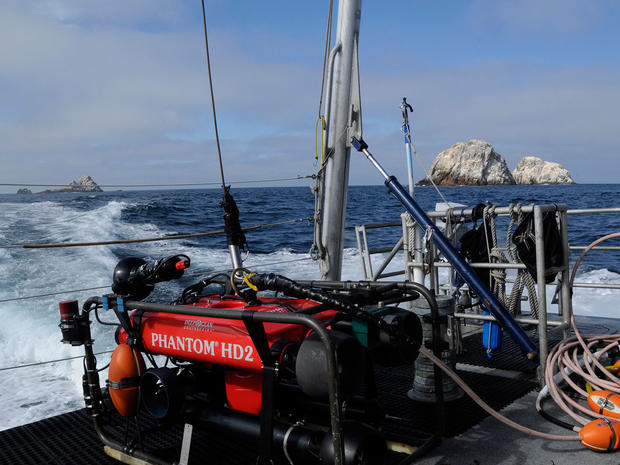"Graveyard of ships" explored off San Francisco
GULF OF THE FARALLONES NATIONAL MARINE SANCTUARY - Federal researchers are exploring several underwater sites where ships sank while navigating in the treacherous waters west of San Francisco in the decades following the Gold Rush.
Over the past week, a team from the National Oceanic and Atmospheric Administration used a remote-controlled underwater vehicle, equipped with sonar and video cameras, to examine and record the historic shipwrecks.
The five-day expedition was part of a long-term archaeological survey of the Gulf of the Farallones National Marine Sanctuary, which covers about 1,300 square miles of the Pacific Ocean off the Northern California coast.
NOAA researchers say more than 300 ships have wrecked in the gulf, where heavy fog, strong winds and protruding rocks have bedeviled many vessels heading in and out of the San Francisco Bay - especially before arrival of sonar and other navigational technologies.
"The Gulf of the Farallones is a graveyard of ships," said James Delgado, NOAA's maritime heritage director. "Every one of these accidents, every one of these sinkings, has its own dramatic story to tell."
The Associated Press accompanied the NOAA team on a research cruise Friday, when they used the underwater vehicle to explore three potential shipwreck sites near the Farallon Islands, a chain of rocky outcroppings about 30 miles west of the Golden Gate Bridge.
At the first target site, Delgado's team had hoped to see the wreckage of the Noonday, a 19th century clipper ship that was transporting railroad tracks and other cargo from Boston when it hit rocks near the Farallones and sank in 1863.
After the researchers dropped the remote-controlled vehicle about 300 feet onto the target site, they watched video monitors that showed the underwater video footage in real-time.
The sonar revealed the outlines of what appears to be a clipper ship, but the researchers didn't see any physical remains of the Noonday, leading them to believe it was buried under the sediment.
"Noonday is there. The sonar is very clear. But there's just nothing sticking above the seabed," Delgado said.
When they dropped the underwater vehicle on the third target, they found the wreckage of the SS Selja, a 380-foot cargo steamship that sank west of Point Reyes on Nov. 22, 1910.
Selja was transporting goods from China to San Francisco in heavy fog when it collided with another ship, the SS Beaver. Two Chinese crew members were lost, but the rest of the Selja crew was rescued.
Cameras on the NOAA team's underwater vehicle revealed the remains of Selja, lying overturned on its starboard side with its hull broken in multiple places. The wreckage had become part of the marine ecosystem, home to numerous fish, sea anemones and other plant life.
"We were actually quite surprised. It was a catastrophic ending for Selja," said Bob Schwemmer, West Coast coordinator for NOAA's maritime heritage program.


